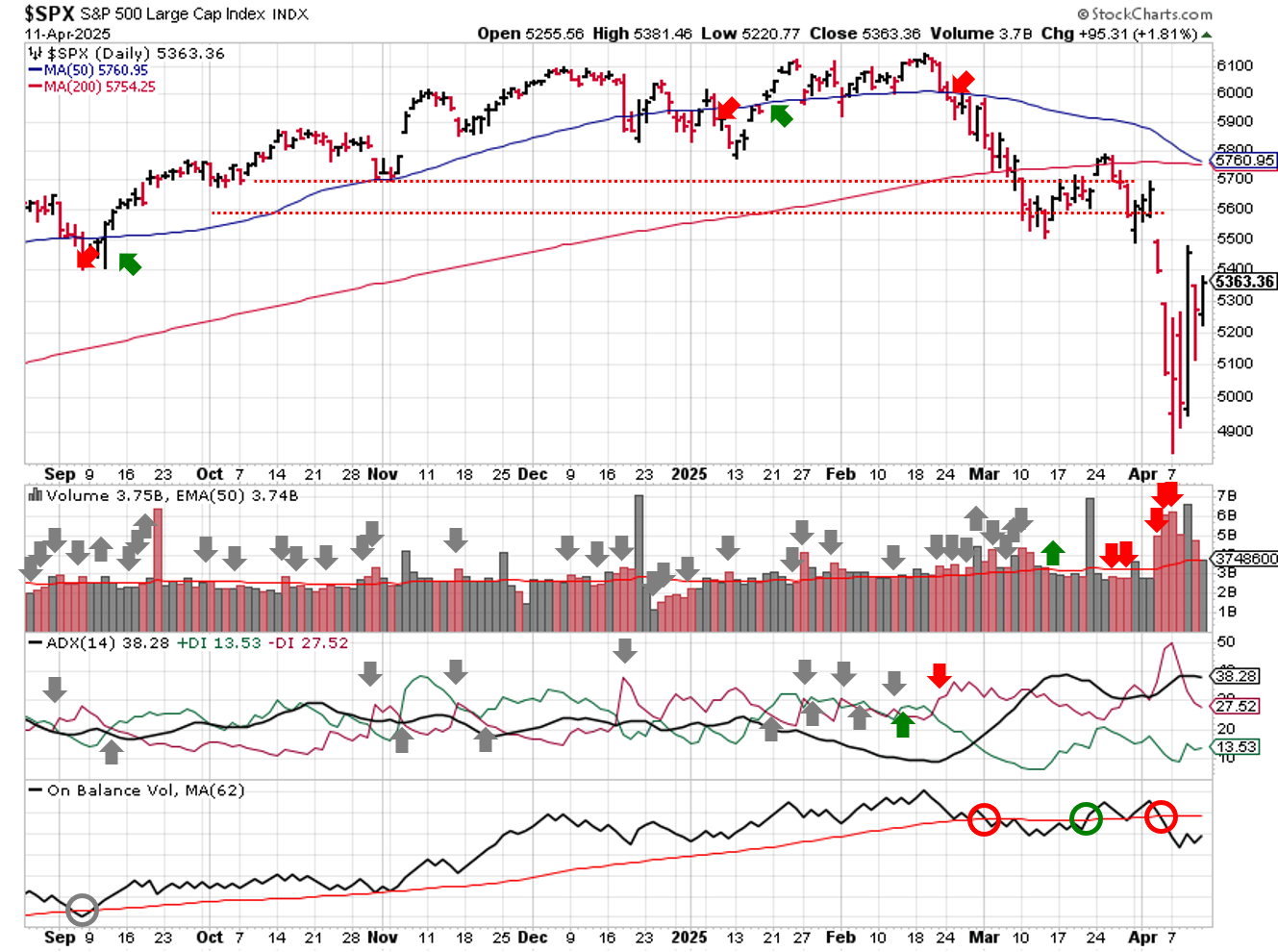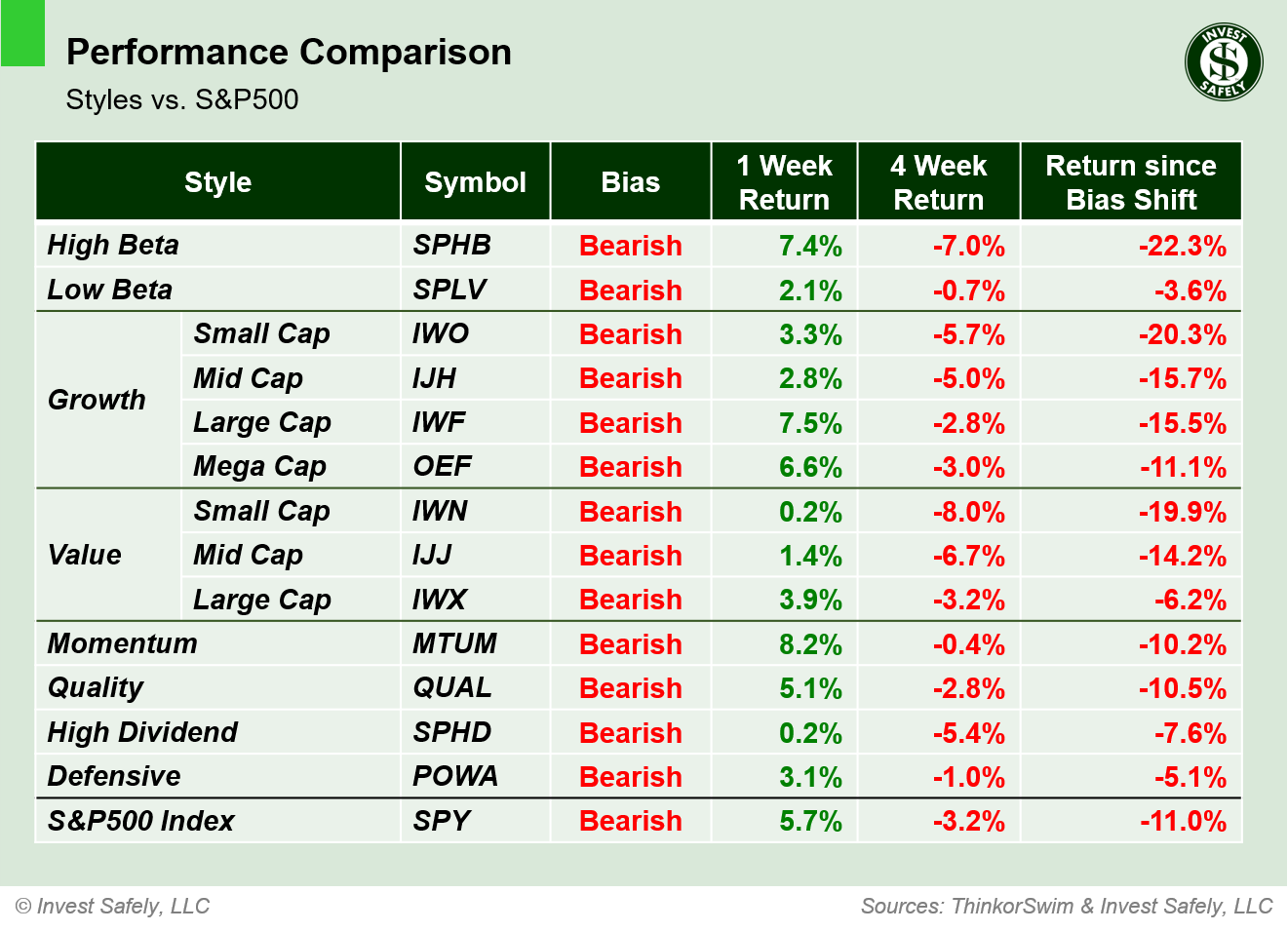Stock Market Outlook
For The Week Of April 13th =
Downtrend
INDICATORS
-
ADX Directional Indicators: Downtrend
Institutional Activity (Price & Volume): Downtrend
On Balance Volume Indicator: Downtrend
ANALYSIS
The stock market outlook remains in a downtrend after another historic week for U.S. equities.
After ALL THAT, the S&P500 ( $SPX ) rose 5.7%. The index sits ~7% below the 50-day moving average and ~7% below the 200-day moving average. The index filled one of the gaps mentioned last week ( 5300 to 5400 ); the other one ( 5500 to 5600 ) remains unfilled.
SPX Technical Analysis - April 13 2025
All three technical indicators ( ADX, OBV, and Institutional Activity ) remains in bearish territory. No surprises here.
Almost all sectors recovered some ground last week, with the Tech sector leading the way. Real Estate fell just shy of break even. Consumer Staples shifted back to Neutral bias; all the other sectors remain bearish.
All sector styles registered a gain last week, with Momentum scoring the largest gain. No changes in bias; all styles remain bearish.
Gold ( $GLD ) was the best asset last week, though equities weren't far behind. Bonds ( $IEF ) and the dollar were the worst asset classes. Bonds also shifted to a bearish bias due to the recent rise in rates.
COMMENTARY
Another wild week for financial markets is in the books. Given the level of uncertainty around outcomes from the new U.S. tariff regime and diplomacy by social media, expect the volatility to continue.
Lost in the noise was improved inflation data. Headline and Core CPI came in lower than expectations, which was welcome news for those hoping for rate cuts at the next FOMC meeting.
| CPI (y/y) | Actual | Prior | Expected |
| Headline | +2.4% | +2.8% | +2.6% |
| Core | +2.8% | +3.1% | +3.0% |
March producer prices (PPI) were also lower in March.
| PPI (y/y) | Actual | Prior | Expected |
| Headline | +2.7% | +3.2% | +3.3% |
| Core | +3.3% | +3.5%* | +3.6% |
The first set of bank earnings beat expectations, but their outlooks didn't instill a lot of confidence about the rest of the year. Long range planning requires some level of certainty, and the "price" of waiting 90 days is much lower than the cost of a strategic misstep.
It's a complex system at work, which means there many "unintended" or "unanticipated" reactions that will catch investors off guard. Rather than try to predict what will happen, watch for more constructive price action: the return of bullish biases, stocks breaking out of solid bases with higher volume, $VIX<20. Until then, build your watchlist rather than deploy capital. The S&P500 has averaged 7% moves intraday since April 2, and that's not how bull markets behave.
Best to Your Week!
P.S. If you find this research helpful, please tell a friend.
If you don't, tell an enemy.
Sources: Bloomberg, CNBC, Federal Reserve Bank of St. Louis, Hedgeye, U.S. Bureau of Economic Analysis, U.S. Bureau of Labor Statistics
Share this Post on:

How to Make Money in Stocks: A Winning System in Good Times and Bad.
It's one of my favorites.
I regularly share articles and other news of interest on:
Twitter (@investsafely)
Facebook (@InvestSafely)
LinkedIn (@Invest-Safely)
Instagram (@investsafely)
Invest Safely, LLC is an independent investment research and online financial media company. Use of Invest Safely, LLC and any other products available through invest-safely.com is subject to our Terms of Service and Privacy Policy. Not a recommendation to buy or sell any security.
Charts provided courtesy of stockcharts.com.
For historical Elliott Wave commentary and analysis, go to ELLIOTT WAVE lives on by Tony Caldaro. Current counts can be found at: Pretzel Logic, and 12345ABCDEWXYZ
Once a year, I review the market outlook signals as if they were a mechanical trading system, while pointing out issues and making adjustments. The goal is to give you to give you an example of how to analyze and continuously improve your own systems.
- 2015 Performance - Stock Market Outlook
- 2016 Performance - Stock Market Outlook
- 2017 Performance - Stock Market Outlook
- 2018 Performance - Stock Market Outlook
- 2019 Performance - Stock Market Outlook
- 2020 Performance - Stock Market Outlook
IMPORTANT DISCLOSURE INFORMATION
This material is for general communication and is provided for informational and/or educational purposes only. None of the content should be viewed as a suggestion that you take or refrain from taking any action nor as a recommendation for any specific investment product, strategy, or other such purpose. Certain information contained herein has been obtained from third-party sources believed to be reliable, but we cannot guarantee its accuracy or completeness.
To the extent that a reader has any questions regarding the applicability of any specific issue discussed above to his/her individual situation, he/she is encouraged to consult with the professional advisors of his/her choosing. Invest Safely, LLC is not a law firm, certified public accounting firm, or registered investment advisor and no portion of its content should be construed as legal, accounting, or investment advice.
The material is not to be construed as an offer or a recommendation to buy or sell a security nor is it to be construed as investment advice. Additionally, the material accessible through this website does not constitute a representation that the investments described herein are suitable or appropriate for any person.
Hypothetical Presentations:
Any referenced performance is “as calculated” using the referenced funds and has not been independently verified. This presentation does not discuss, directly or indirectly, the amount of the profits or losses, realized or unrealized, by any reader or contributor, from any specific funds or securities.
The author and/or any reader may have experienced materially different performance based upon various factors during the corresponding time periods. To the extent that any portion of the content reflects hypothetical results that were achieved by means of the retroactive application of a back-tested model, such results have inherent limitations, including:
Model results do not reflect the results of actual trading using assets, but were achieved by means of the retroactive application of the referenced models, certain aspects of which may have been designed with the benefit of hindsight
Back-tested performance may not reflect the impact that any material market or economic factors might have had on the use of a trading model if the model had been used during the period to actually manage assets
Actual investment results during the corresponding time periods may have been materially different from those portrayed in the model
Past performance may not be indicative of future results. Therefore, no one should assume that future performance will be profitable, or equal to any corresponding historical index.
The S&P 500 Composite Total Return Index (the "S&P") is a market capitalization-weighted index of 500 widely held stocks often used as a proxy for the stock market. Standard & Poor's chooses the member companies for the S&P based on market size, liquidity, and industry group representation. Included are the common stocks of industrial, financial, utility, and transportation companies. The S&P is not an index into which an investor can directly invest. The historical S&P performance results (and those of all other indices) are provided exclusively for comparison purposes only, so as to provide general comparative information to assist an individual in determining whether the performance of a specific portfolio or model meets, or continues to meet investment objective(s). The model and indices performance results do not reflect the impact of taxes.
Investing involves risk (even the “safe” kind)! Past performance does not guarantee or indicate future results. Different types of investments involve varying degrees of underlying risk. Therefore, do not assume that future performance of any specific investment or investment strategy be suitable for your portfolio or individual situation, will be profitable, equal any historical performance level(s), or prove successful (including the investments and/or investment strategies describe on this site).






